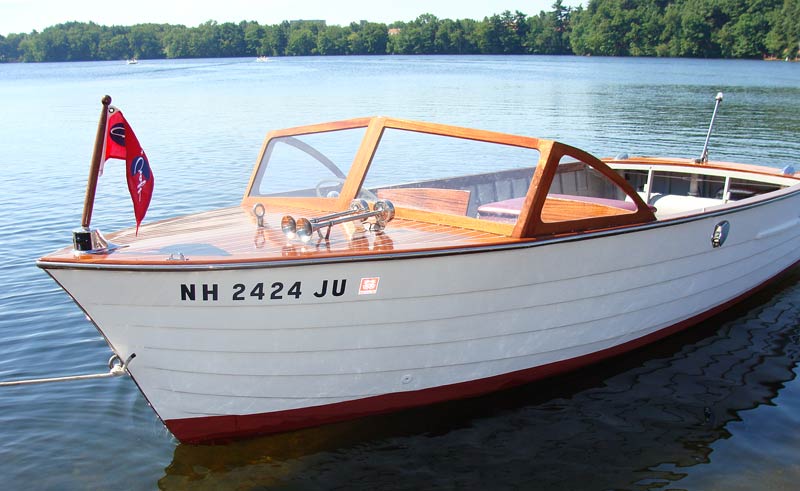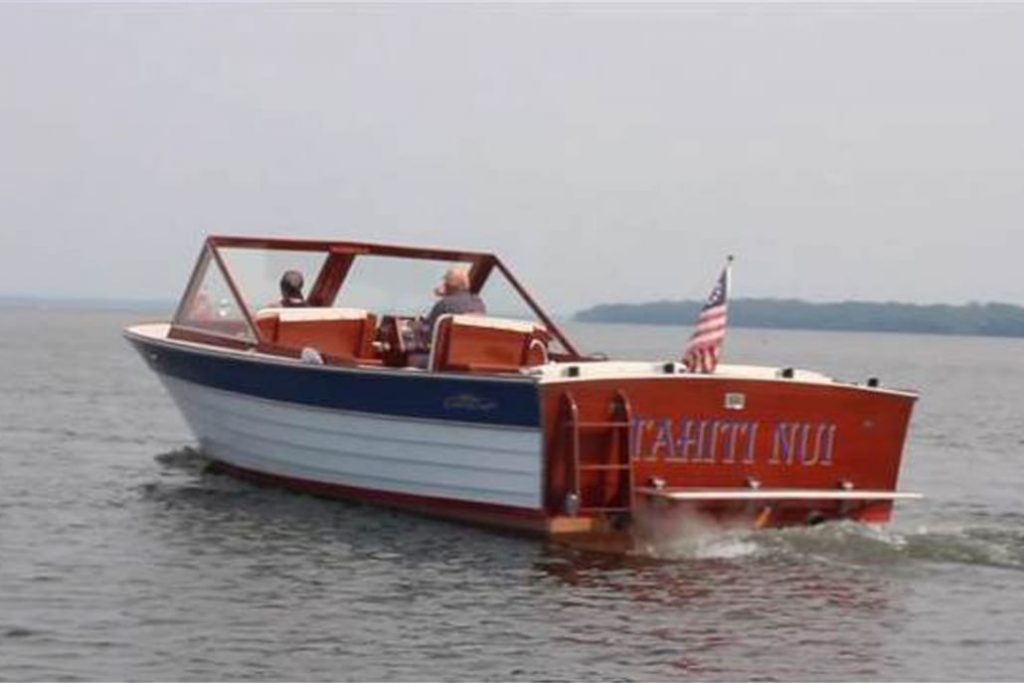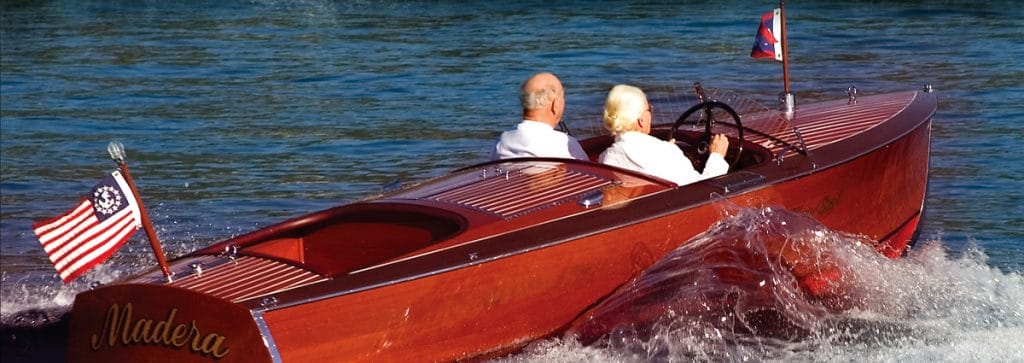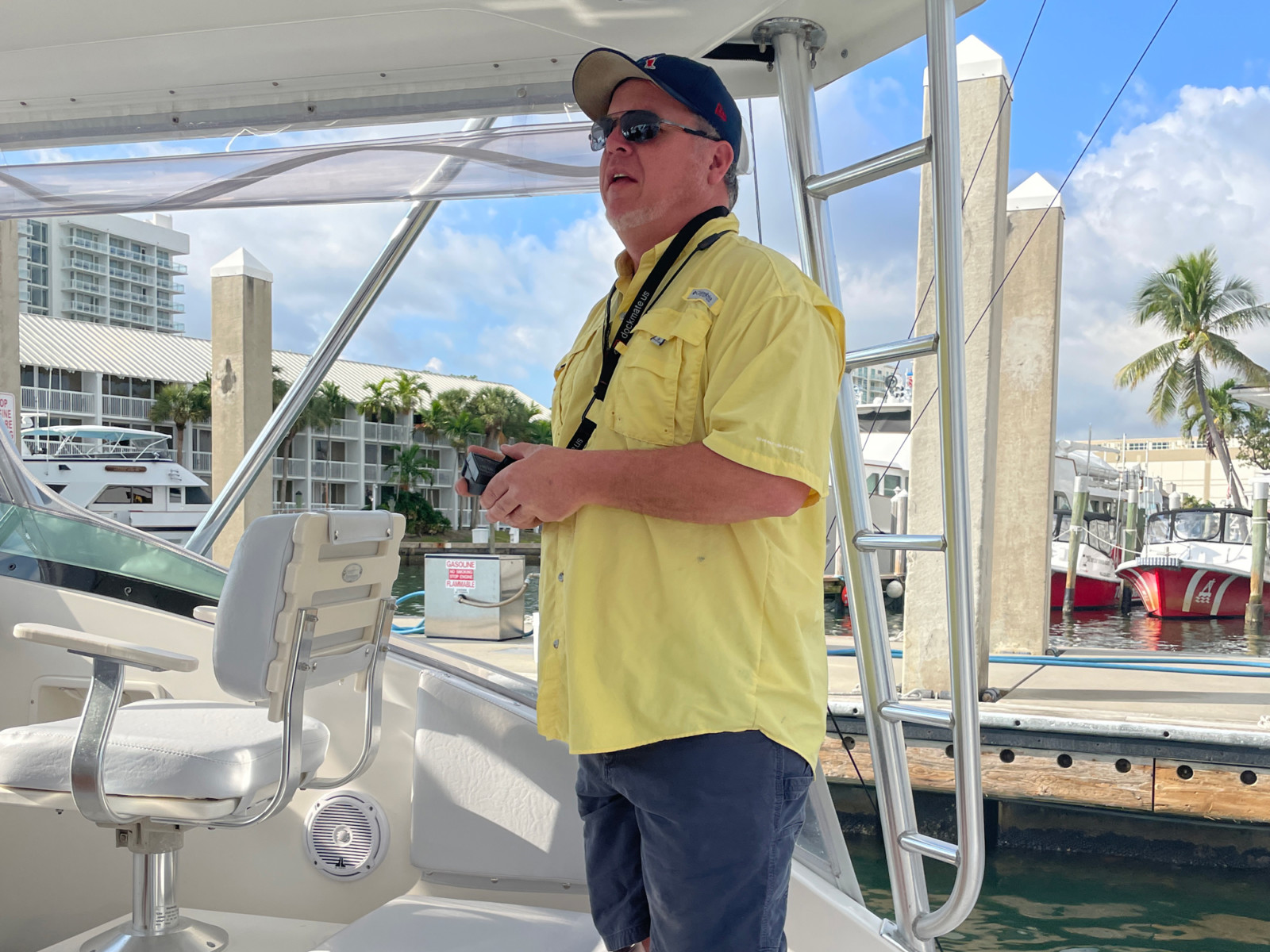Chris Craft Sea Skiffs: Exploring Classic Wooden Boats
Chris Craft Sea Skiffs are an iconic lineup of vintage wooden boats that have gained a loyal following among boating enthusiasts.
Known for their classic design and exceptional functionality, these boats emerged as a result of Chris Craft's dedication to producing high-quality, affordable vessels.

With a strong focus on craftsmanship, Sea Skiffs are a testament to the brand's longstanding commitment to boating excellence.
Originating in the 1950s, Chris Craft Sea Skiffs evolved to meet the changing needs of boaters.
Equipped with open-lapstrake construction, these boats were designed to handle rough water conditions with ease, providing a smooth, comfortable ride.
Throughout the years, several models were introduced, each with its distinctive features and innovations, making Sea Skiffs highly sought after by collectors and enthusiasts alike.

Key Takeaways
- Chris Craft Sea Skiffs are classic wooden boats known for their design and functionality.
- They first gained popularity in the 1950s with innovations like open-lapstrake construction.
- Several models were introduced over the years, making them cherished by collectors and boating enthusiasts.
History of Chris Craft Sea Skiffs
Origins and Development
The history of Chris Craft Sea Skiffs can be traced back to the company's founder, Christopher Columbus Smith, who built his first boat in 1874 at the age of 13.
Smith's boats, referred to as "punts" or "skiffs," quickly earned him a reputation as a master boat builder, and the demand for his boats grew over time.
The Chris Craft company was established in Michigan and soon became known for its high-quality craftsmanship and performance in building wooden boats source.
Over the years, Chris Craft developed a range of powerboats, with the introduction of the 1957 Chris-Craft Sea Skiff marking a significant milestone in the company's history.
The 1957 Chris-Craft Sea Skiff
The 1957 Chris-Craft Sea Skiff was a popular model featuring a classic, antique design.
Known for its strong, durable construction and impressive performance, this boat became a favorite among boating enthusiasts.
With its beautiful mahogany hull and sleek lines, the 1957 Sea Skiff was a true reflection of the craftsmanship and attention to detail that Chris Craft had become famous for.
Some key features of the 1957 Chris-Craft Sea Skiff included:
- Mahogany construction
- Lapstrake design for added strength and reduced weight
- Original engines, such as the Hercules MCL, offering reliable performance
- Prevalence of use in the North Woods area, specifically serving as the main launch to/from a private island estate called Denby Island source

The Rise of Mahogany Powerboats
By the 1960s, Chris Craft had become synonymous with mahogany powerboats, gaining widespread popularity not only in the United States but also around the world.
In 1963, the company celebrated a significant achievement - producing its 50,000th boat source.
This milestone further solidified Chris Craft's reputation as a leading manufacturer of high-quality powerboats and a continued commitment to innovation and craftsmanship.
As time went on, the classic mahogany design of Chris Craft boats would eventually give way to more modern materials. Despite this evolution, the timeless appeal of the Chris Craft Sea Skiffs as antique models remains highly sought after by collectors and boating enthusiasts alike.
Key Models and Features
18' Sea Skiff Series
One prominent model in the Chris-Craft Sea Skiff line is the 18' Sea Skiff. This model is a rare find, known for its durable construction and elegant design.
The 18' Sea Skiff boats were typically built with original wood, giving them a classic and timeless appearance. The interior features a luxurious mahogany bench, providing comfortable seating for passengers.
These boats were primarily used for leisure activities and water sports, offering a smooth and stable ride on the water.
Iconic Designs and Innovations
The Chris-Craft Sea Skiff models throughout the years showcased the brand's ability to innovate and improve upon their designs.
The 1961 Chris-Craft Sea Skiff is a shining example, with a length of 27 feet and a selling price of 27,500 USD at the time. Key features of this model include laminate construction and Cordova-mahogany paneling in the cockpit.
In addition, the 1964 Chris Craft 24' Sea Skiff Ranger offers a powerful performance with a Chris-Craft 283/185 HP V-8 engine.
This model, one of 70 built, boasts Sea Skiff's luxury features and cutting-edge styling at the time.
Here's a brief overview of several different Chris-Craft Sea Skiff models from 1957 to 1964:
- 1957 Chris-Craft Sea Skiff inboard boat models
- 1958 Chris-Craft Sea Skiff inboard boat models
- 1959 to 1960 Chris-Craft Sea Skiff inboard boat models
- 1961 Chris-Craft Sea Skiff inboard boat models
- 1964 Chris-Craft Sea Skiff Ranger
By offering a wide range of models and constantly improving their designs, Chris-Craft ensured that the Sea Skiff series remained a popular choice among boating enthusiasts for many years.
Restoration and Preservation
Process of Restoring a Sea Skiff
The process of restoring a Chris Craft Sea Skiff involves several steps to ensure the boat is brought back to its original condition.
First, the boat is carefully inspected to assess the extent of the damage and identify the parts that need replacement or repair.
This inspection often includes checking the hull, ribs, and topside wood for rot and damage.
Once the necessary repairs have been identified, the boat is then disassembled and any damaged wood replaced.
Refinishing the boat is another crucial step in the restoration process.
This involves sanding down the surfaces, applying a protective layer of varnish or paint, and polishing the boat to bring back its original shine.
In some cases, a varnished engine box cover may also be added to enhance the boat's appearance.
During the restoration, damaged or worn-out components, such as the engine or electrical system, may also need to be replaced or upgraded.
It's essential to use period-correct parts and materials to maintain the boat's authenticity and adhere to its original design.
Fay’s Boat Yard - A Restoration Case Study
Located in Gilford, New Hampshire, Fay's Boat Yard has a reputation for restoring and preserving a variety of classic wooden boats, including Chris Craft Sea Skiffs.
One example of their work is a fully restored and refinished Chris Craft Sea Skiff, completed with great attention to detail.
The restoration process at Fay's Boat Yard starts with a thorough evaluation of the boat's condition and a plan for the required work.
During the restoration, the team at Fay's Boat Yard ensures that every part of the boat is meticulously repaired or replaced, as needed, using high-quality materials.
For a Chris Craft Sea Skiff, the restoration process at Fay's Boat Yard may include replacing damaged ribs, fixing delaminated transom edges, and making other necessary structural repairs.
Once these repairs are done, the boat is refinished, and the engine is either rebuilt or upgraded to match the boat's original specifications.
With the commitment to quality and attention to detail that Fay's Boat Yard demonstrates in their work, these restored Chris Craft Sea Skiffs are not only beautiful examples of craftsmanship but also functional boats that can be enjoyed for many years to come.
Maintenance and Care
Storage Solutions
Proper storage is essential to prolong the life of a Chris Craft Sea Skiff.
A dry, protected environment is the ideal place to store your boat. Ensuring that the drain plug is removed during storage can prevent water accumulation, as evidenced in a 1962 Chris Craft Sea Skiff restoration.
Investing in a high-quality boat cover is also helpful, as it keeps the vessel protected from dust and debris.
Maintaining Original Features
To preserve the classic charm of a Chris Craft Sea Skiff, it's important to maintain the original features such as gauges and head.
Even though new gauges may be more accurate, restoring the original gauges can help maintain the boat's aesthetic and historical value.
Gauges: The best approach in maintaining original gauges is to clean them regularly and perform regular inspections. In case of a malfunction, it is advisable to consult an expert in classic boat restorations rather than replacing the gauges with new ones.
Head: Maintaining the head of your Sea Skiff involves regular cleaning, proper functioning of the plumbing system, and ensuring that the components are in optimal condition.
In a restoration process, like the one documented for a 1961 Chris Craft Sea Skiff, keeping the original parts intact is highly recommended while ensuring their optimal performance.
When it comes to maintaining the overall performance of your Chris Craft Sea Skiff, regular engine checks, and inspections are crucial.
If deemed necessary, consider the option of repowering your vessel with new engines while preserving its original features, such as crate 350s.
Acquisition and Valuation
Finding a Chris Craft Sea Skiff
Locating a Chris Craft Sea Skiff for sale can be an enjoyable experience for vintage boat enthusiasts.
Some Sea Skiffs can be found at local boat yards, such as Fay's Boat Yard near Lake Winnipesaukee.
Others are available online via specialized websites like YachtWorld.
When searching for a Sea Skiff, it's essential to consider the following factors:
- Location: Determine if the boat is nearby or requires transportation.
- Condition: Check if the boat is in good condition or needs restoration.
- Maintenance history: Ensure the boat has been properly maintained, such as a Chris Craft 283 engine professionally serviced by facilities like Frontier Classics.
Determining the Value of Antique Boats
Valuing an antique boat can be challenging due to their unique features and scarcity. However, several factors can help in estimating the value of a Chris Craft Sea Skiff:
- Age: Older models may be rarer and more valuable. The 18' Sea Skiffs, for instance, had just 934 units produced between 1954 and 1959.
- Condition: Well-preserved boats with original parts and minimal wear are generally more valuable.
- Restoration: The quality of restoration, if applicable, can significantly impact an antique boat's value. High-quality restorations maintaining the original design and using authentic materials will usually add more value.
Some additional resources to help in determining the value of a Chris Craft Sea Skiff include:
- Boat valuation guides: Online resources or printed guides can provide specific pricing information for various antique boat models.
- Auction results: Keep track of recent auction results for similar boats to better understand the market value.
- Experienced appraisers: Getting a professional appraisal from a specialist in antique boats can be an excellent way to obtain an accurate and reliable valuation.
Modern Upgrades and Customization
Engine Replacement Options
One popular upgrade for a Chris Craft Sea Skiff is a new engine replacement.
A recent example involved repowering a 1963 Chris Craft Sea Skiff with a 327 Chevy/Barr marine conversion.
This type of engine upgrade can improve performance and reliability for the boat, ensuring a smooth and enjoyable experience on the water.
Adding Modern Comforts
In addition to engine upgrades, several other modernizations can be made to enhance the comfort and usability of a classic Chris Craft Sea Skiff.
For instance, rear bench seating can be added to create a more welcoming and social atmosphere for passengers.
A walk-through cutout can also be installed to allow for easier movement between the cockpit and the swim platform, increasing functionality and usability.
Another modern touch that owners can consider adding is the installation of new gauges in the instrument panel.
Fully restored gauges not only improve the aesthetics but also ensure accurate readings, which are essential for safe boating.
Here are a few examples of modern comforts that can be added to a Chris Craft Sea Skiff:
- Rear bench seating: Provides extra guest seating and a social atmosphere
- Walk-through cutout: Allows for easier access to the swim platform
- New gauges: Enhances the instrument panel, ensuring accurate readings
- Modern lighting: Upgraded cockpit lighting for better visibility and ambiance
- Dual battery system: Provides reliable power to electronic devices and equipment
Frequently Asked Questions
How can I determine the model year of a Chris-Craft boat?
Determining the model year of a Chris-Craft boat can often be achieved by locating the hull number, usually found on the upper starboard corner of the transom or on a plate inside the boat.
You can then cross-reference this number with Chris-Craft resources or consult knowledgeable enthusiasts online.
What are the unique features of a 1957 Chris-Craft Sea Skiff?
The 1957 Chris-Craft Sea Skiff is characterized by its lapstrake wooden hull construction, which offers increased strength and durability.
These boats typically feature a beamy and spacious design, allowing for comfortable cruising and entertaining on the water. The Sea Skiff may include a variety of engine choices, made available by Chris-Craft during the period.
What is the average cruising speed of a typical Chris-Craft Sea Skiff?
The average cruising speed of a Chris-Craft Sea Skiff depends on the size and engine configuration of the specific model.
Generally, these boats can cruise comfortably at speeds between 15 to 25 knots, providing a smooth and leisurely ride. Of course, individual performance may vary depending on engine conditions, weight, and other factors.
Are there specific maintenance considerations for Chris-Craft wooden boats?
Wooden boats, such as Chris-Craft Sea Skiffs, require regular maintenance to protect and preserve the integrity of the hull.
Key areas of focus include treating and sealing the hull to prevent rot, regularly painting or varnishing the exterior, and inspecting for signs of damage or wear. Owners need to pay close attention to the boat's hardware and engine systems as well.
Wooden boat enthusiasts often suggest additional research and joining online forums for more tips and guidance.
How can one verify the authenticity of a Chris-Craft hull number?
Verifying the authenticity of a Chris-Craft hull number can be done by consulting with the Chris-Craft Antique Boat Club, which maintains records and resources to help identify and authenticate boats.
Additionally, reaching out to knowledgeable enthusiasts and researchers can offer further guidance. It is important to keep in mind that hull numbers may have been altered or replaced during major restorations or repairs.
What should one look for when buying a used Chris-Craft Sea Skiff?
When purchasing a used Chris-Craft Sea Skiff, potential buyers should carefully inspect the overall condition of the hull, focusing on signs of rot or damage.
Reviewing the boat's history and any available documentation is important as well.
Prospective buyers should also assess the condition of the engine, electrical systems, and hardware to ensure a safe and reliable boating experience.
Seeking professional advice or hiring a surveyor can be beneficial during this process.
Charlie is Editor-in-Chief of Sea Magazine







